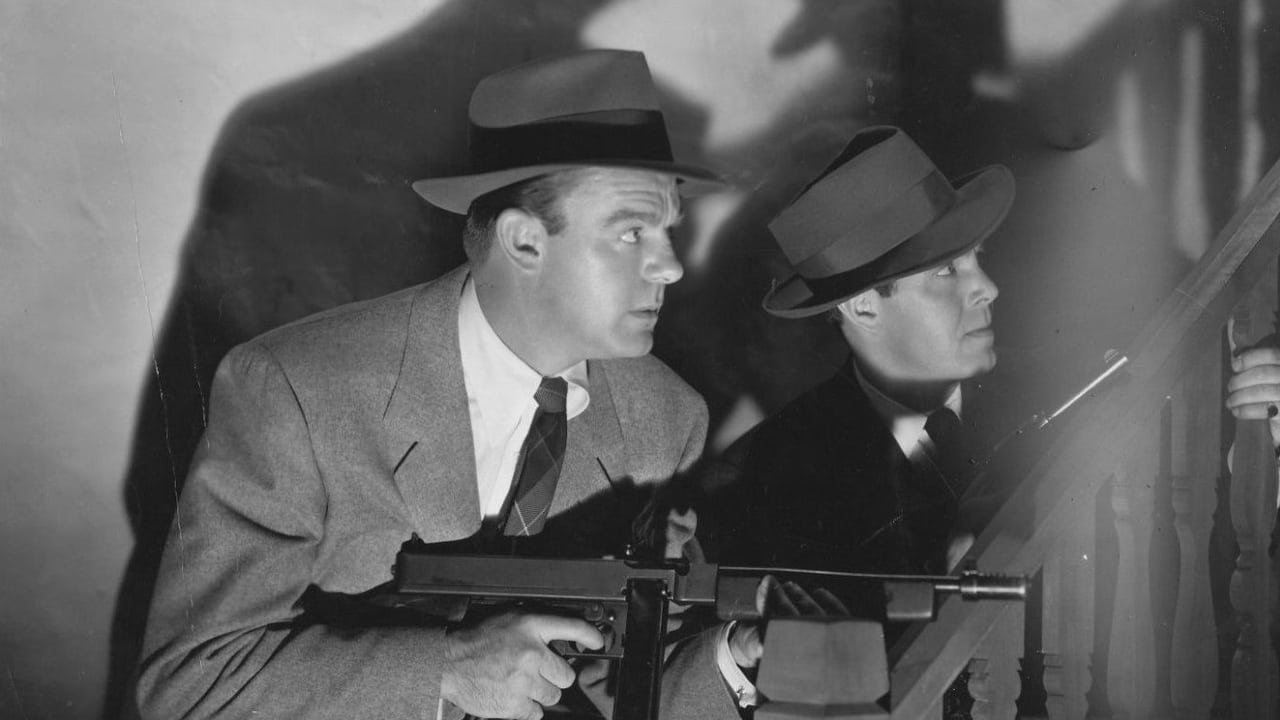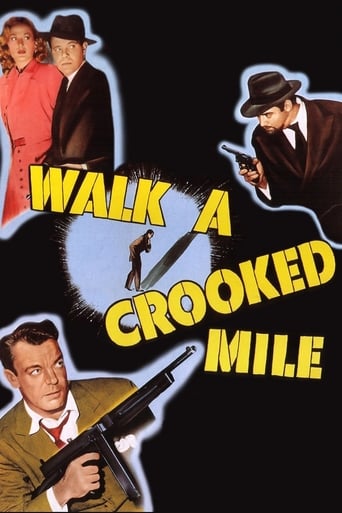

It occurred to me while watching this picture that if made just a few years earlier, it could have served well as a Sherlock Holmes film. A couple that come immediately to mind are "Sherlock Holmes and the Voice of Terror" and "Sherlock Holmes in Washington". The difference though, in the case of "Walk a Crooked Mile", is the presence of those nasty Russian Commies in the place of Nazi agents. The opening screen narrative pays tribute to those federal agents who defend the country against saboteurs and no-goodniks who would 'walk a crooked mile' to do their dirty deeds.The story is tightly scripted with a number of twists and turns while teaming FBI Agent Dan O'Hara (Denis O'Keefe) with Scotland Yard counterpart Philip Grayson (Louis Hayward). O'Hara takes it upon himself to nickname Grayson 'Scotty' in service to his employer, I thought that was a rather nifty touch. The action takes place in Southern California and involves smuggling newly defined mathematical formulas out of the country by way of concealing them in artwork of San Francisco cityscapes. The intrigue involved in making this discovery was cleverly done, and though it occurs rather quickly for the sake of the story, one has to wonder about the number of man hours involved in the undercover work required to break a case like this.Just as in the Holmes films, proper devotion to the cause of patriotism on both sides of the Atlantic is displayed, but not in a way one might think and not via any of the principals. At one point, Grayson's landlady (Tamara Shayne) is roughed up, shot and killed by low-life Commie Krebs (an austere Raymond Burr), and with her dying breath, extols the virtue of a country that did so much for her. Grayson and O'Hara were suitably impressed.The film showed up on one of the cable channels in my area, featured as part of a noir film lineup, but for my money it more closely resembled an espionage thriller. It's got noir elements certainly, and if you want to consider Louise Albritton's role in the picture as your basic femme fatale, it would have worked, but she was eventually exonerated as part of the research lab team that included the traitors working for the Communists. I had to control my disdain for the character of Dr. Allen (Charles Evans) at the finale, one of the bad guys who disingenuously asserted his Constitutional rights when his treasonous role was discovered. Sounds kind of familiar when applied to present day, doesn't it?
... View More**SPOILERS** With hard edge news documentary style narrating by Reed Hadley the film "Walk a Crooked Mile" was made and released by Hollywood during the congressional hearing about Hollywood possible being run by crypto Communists both behind and in front of the camera. It was suspected by many in the US Congress and Senate that they were secretly brainwashing the clueless US movie audiences on the wonders of the Communist system by incorporating them into their films. In the film there's this Communist spy ring that unfiltered the Lakeview Nuclear Labs in Southern California who's been stealing formulas in advance nuclear physics and atomic bomb making.It's up to FBI Secret Agent Dan O'Hara, Dennis O'Keefe, and his partner from across the ocean Scotland yard investigator Philip Grayson, Louis Hayward, to crack the ring and bring those in it to justice. What makes both O'Hara & Grayson's job so difficult is that the sneaky Communists have a secret system of sneaking out the information to their outside contact in far off San Francisco from right under the FBI's noses! What's even worse is if that any one of the crew of Communists screws up and is about to be pinched or arrested by the FBI and spill the beans on them they suddenly end up dead.A bit over the top in how the Communist agents use strong arm tactics that in fact would, like it did in the film, exposed not hide them in plain sight from the FBI as well as local police. Among the Communist goons who do the dirty work for them is future TV Perry Mason Raymond Burr as Krebs who's Mafia like bone and head breaking actions do far more harm to their cause then help it.It takes a while for both O'Hara & Grayson to find out not just how the Communist ring inside Lakeview not only sneaks out the important information but who's the person in charge of it. By then the two were caught worked over and almost killed by the Communist agents and their goons who had so many chances to murder them but somehow didn't. This in fact made them look far more decent then they were supposed, in showing what murderous rats they are, to be in the movie. That by not batting an eye in gunning down or poisoning anyone, even among themselves, whom they slightly suspected was a danger to their secret plans.***SPOILERS*** In the end both O'Hara & Grayson finally managed to escape from their butterfingered Communist captors and finally track down the head of the Communist ring at the Lakeview Nuclear Labs but only after O'Hara is again almost killed by the Communists on his way to meet Gryson and with the help of the local police and FBI arrest him. Still after being caught "red handed " the head man of the Communist ring at the Lakeview Nuclear Labs will be protected of his rights as an American citizen guaranteed by the US Constitution that he and his fellow Communist secret agents were so desperately, to the point of murder, trying to destroy.
... View More"The House on 92nd Street" -- a paean to the FBI's anti-Nazi effort during the war -- begat a host of similarly structured films. There is some kind of MacGuffin, often involving microfilm, winding up "in the wrong hands" and being smuggled out of the country. There is the FBI at the center of the story, successfully unraveling the mystery. The FBI uses awesomely modern technology, such as spy cameras, one-way mirrors, hidden microphones, and files containing thousands of fingerprints. The FBI are business-like but they're good Joes too, wisecracking with one another without ever forgetting their mission. The enemy are cold-blooded, gruff, don't say hello to one another, never smile except wryly, sacrifice one of their own at the drop of a solecism, and are clever in the way that sewer rats are clever. Narration invariably by the stentorian baritone of Reed Hadley.Reed Hadley narrates this one too, coming several years after "The House on 92nd Street." At Lakeview Laboratory, somebody seems to be smuggling out confidential formulae about rockets, trajectories, nuclear physics, the secret ingredients of Coca-Cola, and such to a spy -- Russians, this time around, not Nazis -- who then PAINTS THEM into a landscape of San Francisco and ships them to another spy in London. And so on and so forth.Dennis O'Keefe is the agent in charge of the investigation. Louis Hayward is the Scotland Yard detective who uncovers the plot and comes to the states to work with the FBI. They both had leads in minor pictures but they were steady and reliable actors. Onslow Stevens plays a character whose name is Igor Braun. I leave it to you to guess whether this is one of the good guys or the bad guys. That's -- Igor -- Braun. Raymond Burr is a plump, bearded heavy. He doesn't make any jokes but neither do any of the other rats. He's satisfactorily sadistic. Tamara Shayne, as an innocent landlady, gives the best performance in the film. Art Baker, as head of the laboratory, has a voice made for radio.It's all terribly dated and formulaic but I kind of enjoyed it. Gordon Douglas keeps things moving along, nobody torpedoes the movie, the acting is okay, and the mystery is rather interesting, if implausible.Nice, minor job.
... View MoreDennis O'Keefe, (Daniel O'Hara) plays the role as a FBI Agent who is in charge of finding out how a Southern California atomic plant is having leaks of top secret plans and why one of their agents is killed trying to find out this important information. Scotty Grayson, (Louis Hayward) is a Scotland Yard Inspector who is also called into the FBI office and is working with Daniel O'Hara because he has some important information that can help to solve this case. Raymond Burr, (Krebs) plays the role as a communist who is a very dangerous man who will stop anyone trying to upset their plan to obtain this secret information. This picture is dealing with the Cold War period in history and the scientists in the atomic plant are all under investigation. This film is very entertaining and Dennis O'Keefe gave a great performance along with Raymond Burr just starting out his career and giving a great supporting role. Enjoy.
... View More